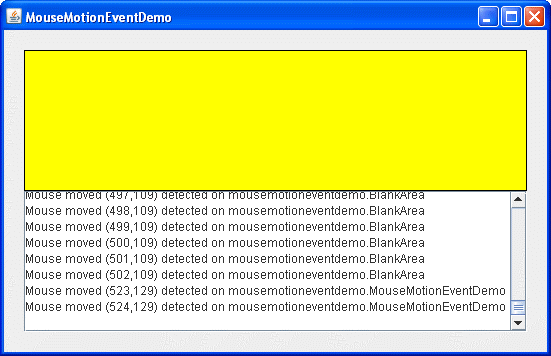Mouse-motion events notify when the user uses the mouse (or a similar input device) to move the onscreen cursor. For information on listening for other kinds of mouse events, such as clicks, see How to Write a Mouse Listener. For information on listening for mouse-wheel events, see How to Write a Mouse Wheel Listener.If an application requires the detection of both mouse events and mouse-motion events, use the
MouseInputAdapterclass, which implements theMouseInputListenera convenient interface that implements both theMouseListenerandMouseMotionListenerinterfaces.Alternatively, use the corresponding
MouseAdapterAWT class, which implements theMouseMotionListenerinterface, to create aMouseMotionEventand override the methods for the specific events.The following demo code contains a mouse-motion listener. This demo is exactly the same as the demo described in the How to Write a Mouse Listener section, except for substituting the
MouseMotionListenerinterface for theMouseListenerinterface. Additionally, MouseMotionEventDemo implements themouseDraggedandmouseMovedmethods instead of the mouse listener methods, and displays coordinates instead of numbers of clicks.
Try this:
- Click the Launch button to run MouseMotionEventDemo using Java™ Web Start (download JDK 6). Alternatively, to compile and run the example yourself, consult the example index.
- Move the cursor into the yellow rectangle at the top of the window.
You will see one or more mouse-moved events.- Press and hold the mouse button, and then move the mouse so that the cursor is outside the yellow rectangle.
You will see mouse-dragged events.You can find the demo's code in
MouseMotionEventDemo.javaandBlankArea.java. The following code snippet fromMouseMotionEventDemoimplements the mouse-motion event handling:public class MouseMotionEventDemo extends JPanel implements MouseMotionListener { //...in initialization code: //Register for mouse events on blankArea and panel. blankArea.addMouseMotionListener(this); addMouseMotionListener(this); ... } public void mouseMoved(MouseEvent e) { saySomething("Mouse moved", e); } public void mouseDragged(MouseEvent e) { saySomething("Mouse dragged", e); } void saySomething(String eventDescription, MouseEvent e) { textArea.append(eventDescription + " (" + e.getX() + "," + e.getY() + ")" + " detected on " + e.getComponent().getClass().getName() + newline); } }The SelectionDemo example, draws a rectangle illustrating the user's current dragging. To draw the rectangle, the application must implement an event handler for three kinds of mouse events: mouse presses, mouse drags, and mouse releases. To be informed of all these events, the handler must implement both the
MouseListenerandMouseMotionListenerinterfaces, and be registered as both a mouse listener and a mouse-motion listener. To avoid having to define empty methods, the handler doesn't implement either listener interface directly. Instead, it extendsMouseInputAdapter, as the following code snippet shows....//where initialization occurs: MyListener myListener = new MyListener(); addMouseListener(myListener); addMouseMotionListener(myListener); ... private class MyListener extends MouseInputAdapter { public void mousePressed(MouseEvent e) { int x = e.getX(); int y = e.getY(); currentRect = new Rectangle(x, y, 0, 0); updateDrawableRect(getWidth(), getHeight()); repaint(); } public void mouseDragged(MouseEvent e) { updateSize(e); } public void mouseReleased(MouseEvent e) { updateSize(e); } void updateSize(MouseEvent e) { int x = e.getX(); int y = e.getY(); currentRect.setSize(x - currentRect.x, y - currentRect.y); updateDrawableRect(getWidth(), getHeight()); Rectangle totalRepaint = rectToDraw.union(previouseRectDrawn); repaint(totalRepaint.x, totalRepaint.y, totalRepaint.width, totalRepaint.height); } }
The Mouse-Motion Listener API
The MouseMotionListener Interface
The corresponding adapter classes are
MouseMotionAdapterandMouseAdapter.
Method Purpose mouseDragged(MouseEvent) Called in response to the user moving the mouse while holding a mouse button down. This event is fired by the component that fired the most recent mouse-pressed event, even if the cursor is no longer over that component. mouseMoved(MouseEvent) Called in response to the user moving the mouse with no mouse buttons pressed. This event is fired by the component that's currently under the cursor. Each mouse-motion event method has a single parameter — and it's not called
MouseMotionEvent! Instead, each mouse-motion event method uses aMouseEventargument. See The MouseEvent API for information about usingMouseEventobjects.
Examples That Use Mouse-Motion Listeners
The following table lists the examples that use mouse-motion listeners.
Example Where Described Notes MouseMotionEventDemoThis section Reports all mouse motion events that occur within a blank panel to demonstrate the circumstances under which mouse motion events are fired. LayeredPaneDemoand
LayeredPaneDemo2How to Use Layered Panes Moves an image of Duke around within a layered pane in response to mouse motion events. SelectionDemoLets the user drag a rectangle to select a portion of an image. Uses a subclass of MouseInputAdapterto listen to both mouse events and mouse-motion events.GlassPaneDemoHow to Use Root Panes Uses a subclass of MouseInputAdapterto listen to mouse events and mouse-motion events on the root pane's glass pane. Redispatches the events to underlying components.ScrollDemoHow to Use Scroll Panes The label subclass, ScrollablePicture, uses a mouse-motion listener to allow the user to scroll the picture even when the user drags the cursor outside the window.


